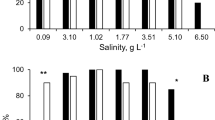Abstract
Chemically mediated crowding effect on induction of diapause egg production in the calanoid copepod Eurytemora affinis was investigated. Two types of eggs, i.e. subitaneous and diapause eggs, produced by females that were reared in crowded culture conditions or the water from crowded culture under excess food supply were examined. 2.3% of the females that were reared at a population density of 5 or 6 animals per 10 ml of filtered lake water (FLW) produced diapause eggs. Females that were reared individually in 2-ml containers with FLW did not produce diapause eggs while 72.7% of females that were individually reared in 2-ml containers, but with water from a crowded culture (500 ind. l−1, culture medium was changed once a week), produced diapause eggs. These results demonstrate that accumulation of their own metabolic products in the medium induces diapause egg production by E. affinis.
Similar content being viewed by others
References
Ban, S., 1992. Effects of photoperiod, temperature, and population density on induction of diapause egg production in Eurytemora affinis (Copepoda: Calanoida) in Lake Ohnuma, Hokkaido, Japan. J. Crustacean Biol. 12: 361–367.
Ban, S., in press. Effect of temperature and food concentration on post-embryonic development, egg production and adult body size of calanoid copepod Eurytemora affinis. J. Plankton Res.
Ban, S. & T. Minoda, 1991. The effect of temperature on the development and hatching of diapause and subitaneous eggs in Euryternora affinis (Copepoda: Calanoida) in Lake Ohnuma, Hokkaido, Japan. Bull. Plankton Soc. Japan, Spec. Vol.: 299–308.
Baretta, J. W. & J. F. P. Malschaert, 1988. Distribution and abundance of the zooplankton of the Ems estuary (North Sea). Neth. J. Sea Res. 22: 69–81.
De Pauw, N., 1973. On the distribution of Eurytemora affmis (Poppe) (Copepoda) in the Western Scheldt estuary, Verh. int. Ver. Limnol. 18: 1462–1472.
D'Abramo, L. R., 1980. Ingestion rate decrease as the stimulus for sexuality in populations of Moina macrocopa. Limnol. Oceanogr. 25: 422–429.
Elmore, J. L., 1982. The influence of food concentration and container volume on life history parameters of Diaptomus dorsalis Marsh from subtropical Florida. Hydrobiologia 89: 215–223.
Ferrari, D. C. & P. D. N. Hebert, 1982. The induction of sexual reproduction in Daphnia magna: genetic differences between arctic and temperate populations. Can. J. Zool. 60: 2143–2148.
Gehrs, C. W. & B. D. Martin, 1973. Production of resting eggs by Diaptomus clavipes Schacht (Copepods, Calanoida). Am. Midl. Nat. 91: 486–488.
Gilbert, J. J., 1963. Mictic female production in the rotifer Brachionus calyciflorus. J. exp. Zool. 153: 113–123.
Gurney, R., 1931. British Fresh-water Copepoda. Vol. 1. The Ray Society, London.
Heinle, D. R. & D. A. Flemer, 1975. Carbon requirements of a population of the estuarine copepod Eurytemora affinis. Mar. Biol. 31: 235–247.
Hobæk, A. & P. Larsson, 1990. Sex determination in Daphnia magna. Ecology 71: 2255–2268.
Katona, S. K., 1970. Growth characteristics of the copepods Eurytemora affinis and E. herdmani in laboratory cultures. Helgoländer wiss. Meeresunters. 20: 373–384.
Klein Breteler, W. C. M., H. G. Fransz & S. R. Gonzalez, 1982. Growth and development of four calanoid copepod species under experimental and natural conditions. Neth. J. Sea Res. 16: 195–207.
Korpelainen, H., 1986. The effects of temperature and photoperiod on life history parameters of Daphnia magna (Crustacea: Cladocera). Freshwat. Biol. 16: 615–620.
Mizuno, T., 1984. Nihon no rikusui san Calanoida (Freshwater Calanoida in Japan). In T. Mizuno et al. (eds), Freshwater Copepods. Tatara Shobo: 475–499. (in Japanese).
Næss, T., 1991. Marine calanoid resting eggs in Norway: abundance and distribution of two copepod species in the sediment of an enclosed marine basin. Mar. Biol. 110: 261–266.
Roddie, B. D., R. J. G. Leadey & A. J. Berry, 1984. Salinity-temperature tolerance and osmoregulation in Eurytemora affinis (POPPE) (Copepods: Calanoida) in relation to its distribution in the zooplankton of the upper reaches of the Forth estuary. J. exp. mar. Biol. Ecol. 79: 191–211.
Slobodkin, L. B., 1954. Population dynamics in Daphnia obtusa Kurz. Ecol. Mongr. 24: 69–88.
Soltanpour-Gargari, A. & S. Wellershaus, 1984. Eurytemora afnis - the estuarine plankton copepod in the Weser. Veröff. Inst. Meeresforsch. Bremerh. 20: 103–117.
Soltanpour-Gargari, A. & S. Wellershaus, 1985. Eurytemora affinis - one year study of abundance and environmental factors. Veröff. Inst. Meeresforsch. Bremerh. 20: 183–198.
Stross, R. G., 1969a. Photoperiod control of diapause in Daphnia. II. Induction of winter diapause in the Arctic. Biol. Bull. 136: 264–273.
Stross, R. G., 1969b. Photoperiod control of diapause in Daphnia. III. Two-stimulus control of long-day, short-day induction. Biol. Bull. 137: 359–374.
Stross, R. G., 1987. Photoperiodism and phased growth in Daphnia populations: coactions in perspective. Mem. Ist. ital. Idrobiol. 45: 413–437.
Stross, R. G. & J. C. Hill, 1965. Diapause induction in Daphnia requires two stimuli. Science 150: 1462–1464.
Tauber, M. J., C. A. Tauber & S. Masaki, 1986. Seasonal adaptations of insects. Oxford University Press, New York.
Walton, W. E., 1985. Factors regulating the reproductive phenology of Onychodiaptomus birgei (Copepods: Calanoida). Limnol. Oceanogr. 30: 167–179.
Author information
Authors and Affiliations
Rights and permissions
About this article
Cite this article
Ban, S., Minoda, T. Induction of diapause egg production in Eurytemora affinis by their own metabolites. Hydrobiologia 292, 185–189 (1994). https://doi.org/10.1007/BF00229940
Issue Date:
DOI: https://doi.org/10.1007/BF00229940




